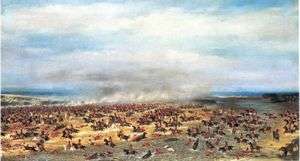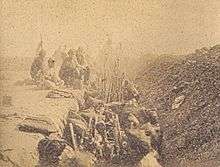Battle of Tuyutí
The Battle of Tuyutí was a Paraguayan offensive in the Paraguayan War targeting the Triple Alliance encampment of Tuyutí. It is considered to be the bloodiest battle ever in South America.[1]:94 The result of the battle was an Allied victory, which added the to Paraguayan troubles that had begun bu failed offensives and the loss of its fleet in the Battle of Riachuelo. Another attack on the Allied camp was made in November 1867.
| Battle of Tuyutí | |||||||
|---|---|---|---|---|---|---|---|
| Part of the Paraguayan War | |||||||
 Painting by Cándido López | |||||||
| |||||||
| Belligerents | |||||||
| |||||||
| Commanders and leaders | |||||||
| |||||||
| Strength | |||||||
|
|
| ||||||
| Casualties and losses | |||||||
|
13,000[2] (6,000 killed 7,000 wounded) |
3,931[2] (996 killed 2,935 wounded) | ||||||
Strategic situation
.jpg)
In this phase of the war the Allies' strategic objective was to take the Fortress of Humaitá, the gateway to Paraguay. They intended to launch an amphibious operation, which required their land forces to take the fortress from the rear. After crossing the Paraná River from Argentina and landing in Paraguay, they had a long march across country studded with lagoons and carrizal (reed beds growing in marsh). The fortress was defended by the extensive earthworks of its Polígono or Quadrilateral design. It was in this context that the Battle of Tuyutí occurred.
Preliminaries
In early May 1866, the Paraguayan attack at the Estero Bellaco marsh failed. The allies camped for over two weeks before resuming their advance on 20 May 1866. Paraguayan leader Francisco Solano López moved his headquarters to Paso Pucu, where he dug trenches in the passes from Gomez to Rojas.[1]:53 After learning that the Allied army were planning to attack on the 25th, Lopez ordered a surprise attack on Tuyutí, "a swampy, scrub-brush savannah",[3] for the 24th.
The 24 May 1866 battle of Tuyutí is known as the First Battle of Tuyutí; the second Battle of Tuyuti (1867) occurred on 7 November 1867.[4]
Battle

The Paraguayans attacked in three columns at 11:55 after a Congreve rocket signaled the attack. Gen Vincente Barrios, with 8,000 infantry and 1,000 cavalry attacked the Allied left, which were Brazilians under the command of Gen. Osorio. Gen. Isidoro Resquín, with 7,000 cavalry and 3,000 infantry attacked the Allied right flank. Col. Jose Diaz with 6,000 infantry and 1,000 cavalry attacked the Allied center, Gen. Flores' Vanguard Division. Col. Hilario Marco, with 7,000 men and 48 cannons, formed the reserve at Estero Rojas[1]:53–54
The attack began in the center, where the Uruguayans were forced back along with some Brazilian Volunteer battalions. On the left of the Allied encampment, Captain Emilio Mallet had ordered the construction of a large moat in front of his artillery pieces. When the Paraguayan onslaught reached it, they were in grapeshot range and unable to cross the obstacle. The Paraguayans tried to circle the artillery, avoiding the incoming fire, but encountered Antonio Sampaio's 3rd Infantry Division. This unit fought desperately in the muddy terrain though their commander died in the process. At this point, Osório ordered his reserves to attack and repelled the Paraguayan center.
On the allied left, the Paraguayans forced back the few Brazilian units, almost reaching the Allied camp. Osório reinforced the Brazilian lines with various units, finally committing the 2nd Cavalry Division, commanded by General Mena Barreto. The Paraguayans continued to attack until they were encircled and annihilated. In the Argentine sector, the Paraguayan cavalry under Gen. Resquín routed the Argentine cavalry under Gens. Caceres and Hornos.[1]:54
Soon the battle turned into "a series of charges and countercharges, a Latin American version of Waterloo".[3] The Paraguayan columns continued to attack, but could not overcome the allied firepower.[1]:54 In the words of Colonel Thompson of the Paraguayan army (a veteran of the battle), "At 4 p.m. the firing was over, the Paraguayans being completely defeated, and their army destroyed. The Allies had suffered severely also, but they still had an army left. The Paraguayans left 6,000 dead on the field; the Allies only took some 350 prisoners, all wounded. This was because the Paraguayans would never surrender but, when wounded, fought on till they were killed. 7,000 wounded were taken into the Paraguayan hospitals from this battle, those with slight wounds not going into hospital at all. . . . The Allies lost above 8,000 killed and wounded."[5]
Aftermath
As result of the battle, each side's losses were as follows:
| Killed | Wounded | Total casualties | ||||||||
|---|---|---|---|---|---|---|---|---|---|---|
| Paraguayans | 6000 | 7000 | 13000 | |||||||
| Allies | 996 | 2935 | 3931 | |||||||
| Argentinians | 126 | 480 | 606 | |||||||
| Brazilians | 737 | 2292 | 3029 | |||||||
| Uruguayans | 133 | 480 | 613 | |||||||
| Sources: Adib Murad, A batalha de Tuiuti e uma lição de civismo, Rio de Janeiro, Biblioteca do Exército, 1957, p. 23; Augusto Tasso Fragoso, História da Guerra entre a Tríplice Aliança e o Paraguai, Rio de Janeiro, Imprensa do Estado-Maior do Exército, 1934-5, vol. II, p. 459 | ||||||||||
There have been contradictory reports about the casualty numbers and debates over the true values.[2] Centurión, reported that Paraguayan dead numbered about 5,000, maybe more, and the wounded 7,000, while the allies lost 8,000 killed and wounded.[6] Thompson agreed with the number of Paraguayan wounded, but claimed that 6,000 were killed.[7] Other authors give different numbers: in Barreto's opinion 6,500 Paraguayans were killed, while allied casualties were 3,647, with 3,011 Brazilians.[8] According to Silva Pimentel 7,000 Paraguayans were killed.[9] Rawson and Beverina also declared that 7,000 Paraguayans were killed along with "so many others wounded", while the allied casualties were 4,000.[10] Osorio's Order of the Day affirmed that the Paraguayan dead numbered "more" than 3,000, with 200 wounded and 21 prisoners; according to this document, Brazilian casualties were 412 killed and 2,003 wounded.
Tuyutí was the last major Paraguayan attack. Ultimately, it was a devastating Paraguayan defeat. "The 10,000 men who had not been killed or [seriously] wounded were completely scattered and disorganised, and it was some days before they were again collected", wrote Thompson. "The Allies buried some of their own dead, but they heaped up the Paraguayan corpses in alternate layers with wood, in piles of from 50 to 100, and burnt them. They complained that the Paraguayans were so lean they that they would not burn".[11]
The largest battle ever fought in South America was over. Lopéz's flanking maneuver had failed, but it had come very close to succeeding. In fact, the Allies were unable to pursue the enemy, since they had few horses remaining. They needed to regain strength and rebuild.[1]:57[12]
The Allied forces stayed in their camp until September,[1]:54 but disease struck the camp, claiming some 10,000 victims.[1]:57 Even after September, advances were little and the allied lines settled down to await further orders. These months of static warfare were filled with small-scale skirmishes and sporadic fire, being known in the Allied forces as the "Tuyutí Black Lines[13]".
Col. Mallet's hidden ditch, the Fosso de Mallet, was the inspiration for Mallet's famous battle cry, "Por aqui não entram". The Brazilian 3rd Division suffered enormous casualties while their commander, Gen. Sampaio, shouted, "Fogo, Batalhão!".[1]:54
References
- Hooker, T.D., 2008, The Paraguayan War, Nottingham: Foundry Books, ISBN 1901543153
- Doratioto 2003, p. 222.
- Williams 2000.
- Farwell, Byron (2001), The Encyclopedia of Nineteenth-Century Land Warfare: An Illustrated World View, New York: WW Norton, p. 831.
- George Thompson, The War in Paraguay: With A Historical Sketch of the Country And Its People And Notes Upon the Military Engineering of the War, Longmans, Green and Co, 1869, pp. 145-6
- Juan Crisóstomo Centurión, vol. II, p. 102
- George Thompson, La Guerra del Paraguay, p. 110
- José Francisco Paes Barreto, p. 42
- Joaquim S. de Azevedo Pimentel, p. 124
- Manuel Rawson, p. 94; Juan Beverina, p. 216
- Thompson, The War in Paraguay, p.149.
- Fragoso, Augusto Tasso (1934), História da Guerra entre a Tríplice Aliança e o Paraguai [History of the War between the Triple Alliance and Paraguay] (in Portuguese), II, Rio de Janeiro: Imprensa do Estado Maior do Exército
- Cerqueira, Dionísio (1870). Reminiscências da Campanha do Paraguai. Rio de Janeiro: BIBLIEX. pp. 190–205.
Bibliography
| Wikimedia Commons has media related to Battle of Tuyutí. |
- AZEVEDO PIMENTEL, Joaquim S. de. Episódios militares. Rio de Janeiro: Biblioteca do Exército, 1978.
- BARRETO, honorary lieutenant José Francisco Paes. História da Guerra do Paraguay. Recife: Typographia de F. P. de Boulitreau, 1893.
- CERQUEIRA, Dionísio. Reminiscências da Campanha do Paraguai. Rio de Janeiro: Biblioteca do Exército, 1979.
- BEVERINA, colonel Juan. La Guerra del Paraguay (1865-70): resumen histórico. 2nd edition. Buenos Aires: Institución Mitre, 1973
- CENTURIÓN, colonel Juan Crisostomo. Memorias: reminiscencias históricas sobre la Guerra del Paraguay, Asunción: El Lector, 1987, 4 vols
- Doratioto, Francisco (2003), Maldita Guerra: Nova história da Guerra do Paraguai [Damned War: new History of the Paraguayan War] (in Portuguese), São Paulo: Companhia das Letras.
- Dupuy, Trevor N (1991), The Harper Encyclopedia of Military History: From 3500 BC to the Present (4th ed.), New York: HarperCollins.
- Kolinski, Charles J (1965), Independence or Death: The Story of the Paraguayan War, Gainesville: University of Florida Press.
- Leuchars, Chris (2002), To the Bitter End: Paraguay and the War of the Triple Alliance, London: Greenwood.
- Murad, Abid (1957), A Batalha de Tuiuti e Uma Lição de Civismo [The Battle of Tuyutí & a lesson in patriotism] (in Portuguese), Rio de Janeiro: Biblioteca do Exército.
- RAWSON, Lieutenant colonel Manuel. Bibliografía del teniente general Emilio Mitre. [Buenos Aires]
- Scheina, Robert L (2003), Latin America’s Wars, 1: The Age of the Caudillo, 1791–1899, New York: Potomac.
- THOMPSON, George. La Guerra del Paraguay, Asunción: RP Ediciones, 1992 [1st Edition 1869]
- Thompson, George (1869), The War in Paraguay, London: Longmans, Green & Co.
- Williams, John Hoyt (2000), "A Swamp of Blood: The Battle of Tuyuti", Military History, 17 (1): 58–64.